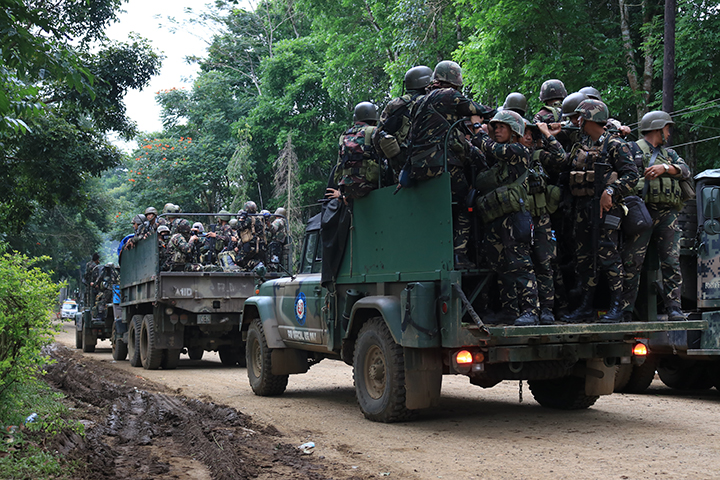
On 23 May 2017, fighting broke out between hundreds of pro–Islamic State (IS) jihadists and Philippine soldiers and police in the city of Marawi in the southern island of Mindanao. As clashes intensified, the Armed Forces of the Philippines quickly deployed thousands of troops and started an aerial bombing campaign that they
initially predicted would be over in days.
Some 12 weeks later, the fighting continues and the toll in death and destruction climbs inexorably, much to the dismay and embarrassment of the Philippine military.
As of 10 August, almost 800 lives had been lost (552 jihadists, 128 soldiers and police, and 119 civilians), more than 1,500 had been wounded, and several hundred thousand civilians had been evacuated to nearby towns and camps. Much of Marawi has been heavily damaged, with observers
likening the destruction to that of Mosul. Once the fighting is over, a massive rebuilding program will be needed.
The battle for Marawi is the most significant terrorist event in Southeast Asia since the Bali bombings of 2002, which killed 202 people. There are several reasons for arguing that. To begin with, it’s the biggest and most successful display of jihadist force by pro-IS fighters in the region to date. At the centre of the jihadist operation is the commander of the Abu Sayyaf group, Isnilon Hapilon, whom the IS central leadership anointed emir of Southeast Asia in mid-2016. Hapilon leads a diverse array of jihadists; among them are several hundred fighters from the locally based Maute group, perhaps a similar number from his own Abu Sayyaf group, and several dozen foreign combatants and middle men including Indonesians, Malaysians and Arabs from the Middle East.
Hapilon’s fighters, especially those from the Maute group, have been far more resourceful and well prepared for urban operations than originally anticipated. They have proven to be expert at using IEDs, ambushing techniques and snipers to kill and unnerve Philippine soldiers. They have also stockpiled large quantities of food and ammunition, and have been able to get more fighters and supplies into their Marawi stronghold despite the government’s attempts to seal off the area.
By contrast, the Philippine armed forces have been exposed as poorly prepared for urban combat and quite unable to deliver on their promises of a quick and comprehensive routing of the insurgents. The fact that the Philippines forces have been supported by US army advisers, as well as US and Australian intelligence operations, has added to the perceived asymmetrical nature of the conflict.
Second, the longer the Marawi jihadists frustrate the Philippine forces and their US advisers, the greater will be their stature among jihadist communities across the region and beyond. Within Mindanao, Hapilon is attracting new recruits, many of them young and well educated, who have become disaffected with larger Muslim organisations, such as the Moro Islamic Liberation Front, which are seen as having sold out by entering into a peace process with the Philippine government. It’s possible that IS leaders will make Mindanao a
wilayat or province, the first region to gain that status in Southeast Asia. Certainly IS has provided generous funding to supporters in Mindanao and continues to praise the Marawi jihadists in its official media outlets.
On extremist social media sites across Indonesia, Malaysia and Singapore, jihadists are expressing their excitement about and admiration for Hapilon’s operations, and there are reports of
growing numbers of IS supporters from those countries seeking to travel to Mindanao so they can participate in the battle. As conditions worsen for IS in Syria and Iraq, more IS partisans in Asia are likely to regard Mindanao as a legitimate alternative.
A longer-term risk it that the struggle in Mindanao gives not only technical expertise but also prestige to a new generation of jihadist leaders from across Southeast Asia, who will then return to their home countries to pass on their skills to pro-IS terrorist cells. Until now, most attacks in the region in support of IS have been of low technical competence and low impact. The infusion of battlefield know-how could substantially increase the terrorist capacity of IS cells.
The Australian government
has made clear its concern about the regional fallout from Marawi. It worries about a rising terrorist threat to its citizens and assets, particularly in Indonesia, which almost a million Australians visit each year. Australia already has a major aid program underway in Mindanao and there are grounds for arguing that it should be expanded. Assisting the rebuilding of Marawi City and supporting the almost quarter of a million displaced people, most of whom are Muslim, is not only a humanitarian imperative but also a means of lessening the risks of further radicalisation and IS recruitment. Perhaps most important of all would be Australia’s continued backing of the Mindanao peace program and plans to establish a Bangsamoro Autonomous Region in Muslim-majority areas. The longer meaningful peace and autonomy are denied to Muslim areas of Mindanao, the more discredited will be the Islamic organisations that are party to the peace process and the greater the opportunity for pro-IS groups to seize the initiative.
 Print This Post
Print This Post